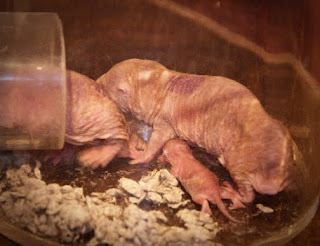
Pictured in the family portrait above are representatives from the three recent naked mole-rat litters born to Pacific Science Center.
The largest mole rat at the bottom of the picture is from Elphaba’s litter born on August 26, 2009, the first successful pups this colony has had in over two years. The mother gave birth to seven pups of which two still survive. These two remaining pups have thrived and grown to about 33 grams in the past eight months. As most of our adult naked mole-rats weigh between 50-60 grams, this means these guys are over halfway full-grown! Not too shabby!
The second-largest naked mole-rat (top left) is from the September 20, 2009 litter, which was the first successful litter for Galinda. From her litter of seventeen pups, six pups have survived and they are just trailing the members of the August litter in weight and size. They are now ranging between 24 and 32 grams. Our biggest problem is trying to tell them apart!

The smallest guy is from Galinda’s March 16, 2010 litter of nineteen. There are thirteen pups from that litter that are still alive and thriving today! We have not yet weighed them because they’re so small and we don’t want to injure them. However, they appear to have just about doubled in size since birth. They seem to be growing at a pretty healthy pace, comparable to the members of the older litters.
How big can our naked mole-rat colony get? Stay tuned because it looks like Galinda is pregnant again!
Read more!




























